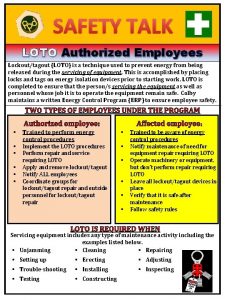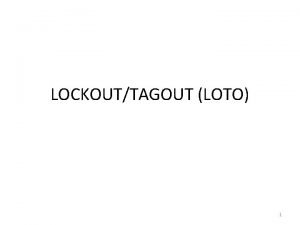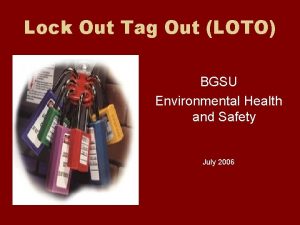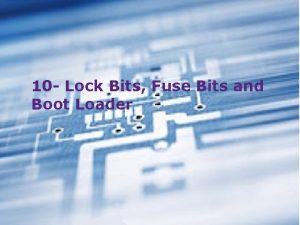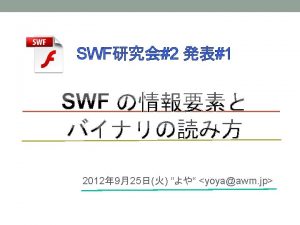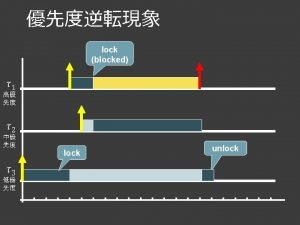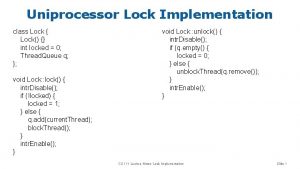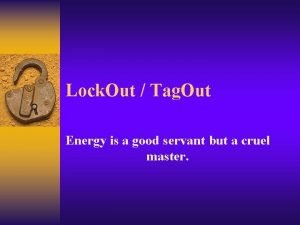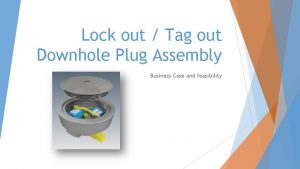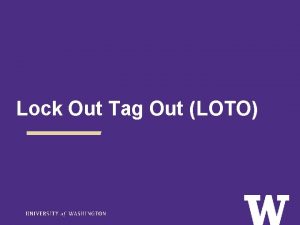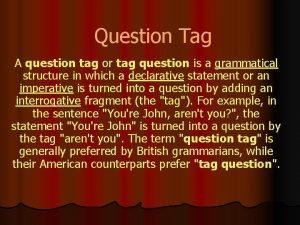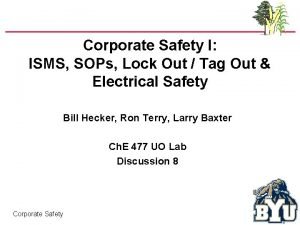UCG TAG OUT LOCK OUT 1 2 3



















- Slides: 19

UCG- TAG OUT LOCK OUT

1. 2. 3. 4. 5. 6. 7. 8. 9. 10. 11. 12. 13. 14. Definitions Reasons for Isolation Lock-out and Tag-out Types of Isolation When is Isolation Required? Authority to Perform Isolations Isolation Process When is Lock-out and Tag-out Required? Lock-out and Tag-Process Removal of Lock-out and Tag-out Returning Plant to Service Damaged or Defective Plant Process for using an “Out of Service Tag” Removal of “Out of Service Tag” Working on Equipment that is Out of Service SAFE WORK PROCEDURE SCOPE:

DEFINITIONS. • Isolation: de-energising plant/equipment and/or disconnecting services such as gas or water or electricity • Lock-out: applying a personal lock to the means of isolation that physically prevents activation of plant, equipment or services • Tag-out: a tag that warns others that the plant, equipment or service is not safe to use

REASONS FOR ISOLATION LOCK-OUT & TAG OUT. Isolation of Services or Maintenance, of Plant & Equipment Damaged or Defective Plant & Equipment Note: There are different tags and requirements for each process

ISOLATION TYPES Types of isolation may include: –Energy sources such as: • Electrical power • Stored kinetic energy (e. g. suspended loads) • Hydraulic power • Pneumatic (air) power –Services such as: • Gas • Water • Supply of other substances such as fuels and oils

When is Isolation Required? Isolation is required when one or more people are conducting: • Maintenance on plant or • Excavation or concrete cutting or • Drilling where there is a risk of: – – – Electrocution Contact/entanglement with moving parts Release or ignition of a substance Accident or inadvertent start-up Use of plant/equipment in an unsafe condition

Authority to Perform Isolations • Isolations should be performed by competent persons who have received training in the correct isolation method for the specified plant, equipment or service. • In some instances -This may mean enlisting the services of a tradesperson such as an electrician.

Isolation Process The following process MUST be followed: 1. Notification to all persons who may be affected 2. Lower elevated objects/equipment (if practicable) 3. Isolate at the main energy supply e. g. Electricity switchboard or Water meter 4. Apply personal danger tags and personal locks 5. Verify the effectiveness of the isolation before work

When is Tag Out Lockout required A Lock-out / Tag-out system must be used each time plant, equipment or services are isolated for maintenance, repair or cleaning. Examples of Personal Locking Devices Padlock with a unique key that can be used to lock isolator switches in the safe OFF position A hasp is used to attach multiple padlocks where more than 1 person is working under the protection of a specific isolation An electrical cord lock-out device used to prevent connection of electrical equipment to the mains power supply

Lock-out & Tag-out Process Each person performing work under isolation must securely attach their Personal Danger Tag, stating: – – Name Date and time of placement Reason for attaching tag Tags are to be used once only Lock-out / Tag-outs must be applied to the point of isolation to prevent accidental start-up. Where multiple people are involved, each person must attach their personal lock.

Removal of Lock and Tag-out • Personal locks and tags may only be removed by the individuals who placed them and only once their work has been completed to a safe standard • Failure of a person to remove their personal lock or tag upon completion of work may result in disciplinary action

Return Plant or Pemises to Service Prior to start-up: 1. All locks and tags must be removed 2. All safeguards must be correctly fitted 3. Notify any persons who may be affected by the start-up 4. Visually inspect and/or conduct a headcount to ensure all workers are well clear of moving parts or electrical supply

Returning Plant to Service It is strictly prohibited to activate plant, equipment or services while a tag or lock is in place.

Damaged or Defective Plant • All employees, contractors and visitors must immediately report damaged or defective plant / equipment to their Site Manager or Supervisor. • If there is any risk of harm to people or plant/equipment, an out of service tag must be used.

Process for using an “Out of Service” Tag Ensure: − The item of plant / equipment is safely isolated − An Out of Service Tag is securely attached to the means of isolation − The defective item is removed from the work area where practicable − Report defective item to Manager or Supervisor

Removal of “Out of Service Tag” The person who placed the “Out of Service Tag” may remove it at any time provided they are competent to determine the plant/equipment is able to resume safe operation.

Removal of “Out of Service tag” Persons authorised to remove another person’s “Out of Service Tag” are: − A tradesperson who has repaired the fault and is satisfied that the item is safe to resume operation − A Supervisor / Leading Hand in charge of the repair work and who is satisfied that the item is safe to return to service

Working on Equipment that is out of Service REMEMBER “Out of Service Tags” do not provide you with protection because they do not identify your presence on the job. It is your responsibility to place your personal danger tag and lock over the “Out of Service Tag” for the duration of your work on the equipment.

Thank You Please proceed with the assessment.
 Lock out tag out safety talk
Lock out tag out safety talk Loto
Loto Ucg vs mcg
Ucg vs mcg Zoran miljanic ucg
Zoran miljanic ucg Peremptorni prigovor
Peremptorni prigovor Bgsu quality systems
Bgsu quality systems Jeden morgen beginnt ein neuer tag
Jeden morgen beginnt ein neuer tag Qrstuvw
Qrstuvw How to write banter
How to write banter Figurative language in one thing by one direction
Figurative language in one thing by one direction Kari lock morgan
Kari lock morgan What can a lock symbolize
What can a lock symbolize Fuse bits
Fuse bits Os161 lock implementation
Os161 lock implementation Past perfect tense not lock
Past perfect tense not lock Hyundai telecom smart lock
Hyundai telecom smart lock Kari lock morgan
Kari lock morgan Intrinsic lock
Intrinsic lock Transaction concurrency
Transaction concurrency Lock in syndrome
Lock in syndrome
